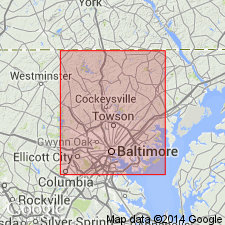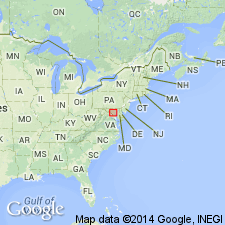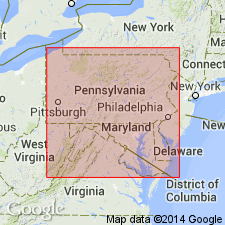
- Usage in publication:
-
- Morgan Run Formation
- Modifications:
-
- Revised
- AAPG geologic province:
-
- Piedmont-Blue Ridge province
Summary:
Morgan Run Formation is considered part of Wissahickon Group in this report. Age of Wissahickon is uncertain and depends on structural interpretation. The following limits apply: Sykesville is younger than 520 my and Loch Raven and Morgan Run are older than 469 my. If rocks are in original stratigraphic order, then the Wissahickon is probably Ordovician. If the Wissahickon is thrusted over the Cockeysville, then the lower Wissahickon is Cambrian. Limits could be even wider. Wissahickon includes the Loch Raven Schist at its base, the Sykesville Formation, which is a diamictite to the southeast, the Morgan Run Formation and the Peters Creek Schist, which are both metagraywackes in the central region, and the Pleasant Grove Formation, a quartz schist, in the northwest.
Source: GNU records (USGS DDS-6; Reston GNULEX).

- Usage in publication:
-
- Morgan Run Formation
- Modifications:
-
- Named
- Dominant lithology:
-
- Schist
- Quartzite
- Amphibolite
- AAPG geologic province:
-
- Piedmont-Blue Ridge province
Summary:
Morgan Run Formation is here described in the central Piedmont of MD as a highly variable assemblage of metaclastic rocks containing lenses and elongate masses of mafic and ultramafic rocks suggesting an origin within a subduction complex. Name is credited to Muller and Crowley (1988, Geologic map of the Finksburg quadrangle, MD). The Morgan Run forms the base of the newly named Liberty Complex, a major tectonostratigraphic unit, which also encompasses the structurally overlying Sykesville Formation to which the Morgan Run supplied coarse metamorphic detritus during collision and uplift. Unit is basically equivalent to the Piney Run Formation as mapped by Muller (1985) along strike to the northeast. To the south, unit is correlative with the Peters Creek Schist mapped by Drake (1985). Five basic lithologies compose the bulk of the unit: medium-grained pelitic schist; fine-grained quartzofeldspathic schist; fine-grained, amphibole-epidote quartzite and quartzitic granofels; medium- to coarse-grained amphibolite and amphibole schist; and fine- to coarse-grained ultramafite. Includes Soldiers Delight slide mass of Crowley (1977). Thickness is estimated at 1,000 to 2,000 m. Interpreted as a melange which was thrust over the Pleasant Grove zone of the Westminster terrane to the west and the Towson terrane to the east. Basal contact is folded and metamorphosed. Final stage of development occurred during Taconic Orogeny. Age of the Liberty Complex shown as Cambrian(?) to Early Ordovician.
Source: GNU records (USGS DDS-6; Reston GNULEX).

- Usage in publication:
-
- Morgan Run Formation
- Modifications:
-
- Revised
- AAPG geologic province:
-
- Piedmont-Blue Ridge province
Summary:
Liberty Complex in the Potomac terrane, MD, is a 2,000-5,000-m-thick assemblage of upper greenschist to lower amphibolite facies metaclastic rocks with intercalated mafic and ultramafic lenses. Complex is composed of (ascending) Soldiers Delight mafic complex, Morgan Run Formation, and Sykesville Formation. Soldiers Delight ultramafic complex is composed of metamorphosed ultramafic rocks with lesser amounts of metagabbro and metapelite and is primarily a serpentinite. Soldiers Delight slide mass included in Morgan Run Formation in original definition and Morgan Run was considered base of Complex.
Source: GNU records (USGS DDS-6; Reston GNULEX).
For more information, please contact Nancy Stamm, Geologic Names Committee Secretary.
Asterisk (*) indicates published by U.S. Geological Survey authors.
"No current usage" (†) implies that a name has been abandoned or has fallen into disuse. Former usage and, if known, replacement name given in parentheses ( ).
Slash (/) indicates name conflicts with nomenclatural guidelines (CSN, 1933; ACSN, 1961, 1970; NACSN, 1983, 2005, 2021). May be explained within brackets ([ ]).

